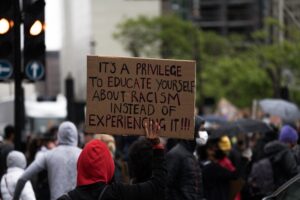By: Amber Burton, Addison Lee, Nicole Mesimer, Kathleen Pennyway, and Eliana Pinckney
This list was developed by several students and teachers at Dreher High School. The students involved led a series of community gatherings called “Get Woke Talks” that centered around issues such as racism, gender identity, and activism. These recommendations come from the lived experiences of the writers. We hope you find them useful.
DO’s
1) Demonstrate care and compassion for your students’ identities.

- Allow students to attend Black History Month Celebrations and other celebrations of their history and culture. These celebrations are not “extra,” they are essential.
- Find books and materials that resonate with your students’ cultural identities. Cover them in class if possible or offer them to students who you know will be interested.
- Show up for your students. If your student is a member of the dance team, or the volleyball team, or the debate team, support them and their interests.
2) Make a consistent effort to correctly pronounce a student’s name.
- Names represent culture. Correctly pronouncing a student’s name can strengthen the relationship with that student, making them feel accepted and included.
- Taking the time to learn a student’s name correctly also shows them that you believe they matter. If you say “it’s too hard” or “I’m never going to learn it,” you are really saying that you do not want to take the time to learn it.
- Don’t give them or ask if they have a nickname, unless they tell you first. By asking your students for an alternate name, you continue the pattern of asking students of color to assimilate to white culture. You are renaming them to make you and/or others more comfortable.
3) Show your students that you are human too.
- Let students know about your failures as well as your successes.
- One of the things discussed in our group was trying to get a banned book approved for the classroom and getting pushback from other stakeholders in the community. This failure led to honest conversations about what teachers can and cannot do in the classroom.
- If you make a mistake or cause harm, apologize, do what you can to repair the harm, and don’t make the mistake again. Expect the same from your students.
4) Be brave enough to take a stand.

- When you encounter injustice, think about the consequences of staying silent, not just the consequences of speaking up.
- Your students of color are watching how you handle racism in the classroom.
- If a student makes a racist comment in your classroom and you say nothing, you are choosing your own comfort over the safety of your BIPOC students.
5) Call things what they are.
- Call racism and other forms of oppression by their names.
6) Be intersectional.
- Kimberlé Crenshaw coined the term “intersectionality” which is a theory describing how all our identities work together and intersect to create different areas of privilege and discrimination.
- Understand that both you and your students interact with the world through various identities.
- When someone speaks from a different lived experience, do not question their truth because you haven’t experienced it.
7) Treat all students of color the same, regardless of the type of classes they take.
- A student who takes all AP and honors classes should be treated the same as a student who only takes CP classes.
8) Include authors from different backgrounds, and not just for work regarding their identity
- BIPOC authors do not just write about racism and racial trauma. There are amazing books that highlight the joy and resilience of BIPOC. Make sure you are including those books as well as ones about racism.
- You don’t have to just use a Black author for books about race; authors create stories for every aspect and concept of life.
9) Make additional efforts to build relationships with students of color and their families.
- Realize that your knowledge of family and cultures is specific, not universal.
DON’Ts
1) Don’t try to be comfortable.
- This work doesn’t end, and if you are comfortable then you are accepting the status quo.
2) Don’t assume that parents are talking to their kids about racism and cultural history.

- Students have different needs and backgrounds.
- Many historical textbooks used in classrooms were written by white authors. Only recently has the erasure of histories of BIPOC been made widely available and accessible.
3) Don’t ask a student of color to speak on behalf of their entire race.
- Communities of color are not monolithic.
- Putting your students of color on the spot and asking them to speak for their race is harmful and unfair.
4) For white teachers: Do not be a white savior. Don’t extend help based on what you assume a student of color needs. This feeds into the assumption all students of color undergo the same issues.
- The white savior complex is ego-driven. It comes from the belief that students of color need “fixing” and that you have the power to do so. This is harmful.
- If a student of color is having a bad day, don’t assume it’s because of the stereotypes associated with BIPOC. (Not all students of color come from low-income households or live with a single-parent, etc.) These students are affected by the same issues non-students of color are affected by.
- A great example of a white savior in the classroom is the movie Freedom Writers.
Learn More About Antiracist Work
This list is not intended to be a complete list of everything you need to know about antiracist teaching, but hopefully this can give you some things to think about as you move forward in your journey. Some other resources you may find useful are listed below.
- Ibram X Kendi’s How to Be an Antiracist and Stamped from the Beginning
- Zaretta Hammond’s Culturally Responsive Teaching and the Brain
- Ijeoma Oluo’s So You Want to Talk About Race
About the Authors

- Amber Burton is 18. In the fall, she will be attending North Carolina A&T State University. She plans to double major in political science and African American studies, with aspirations of becoming a civil rights attorney and a political analyst.
- Addison Lee is 17 and will be attending the University of South Carolina to major in public health. She hopes to minor in Women and Gender Studies in order to work on policy making and advocating for underserved communities.
- Eliana Pinckney is 17. She will be attending Temple University in the fall to major in musical theatre and public relations.
- Nicole Mesimer teaches Spanish at Dreher High School.
- Kathleen Pennyway teaches Theatre at Dreher High School.



